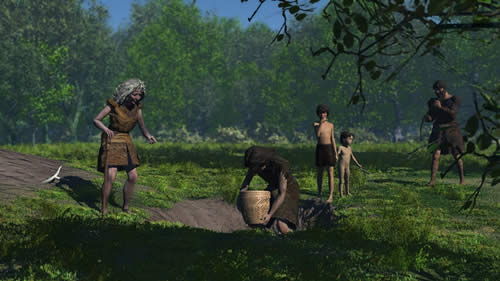- This website reflects our views on the Terminal 5 site based on many years of post-excavation analysis, which culminated in the publication of the final volume of the T5 report in 2010.
The Heathrow Landscape
How do we know this?
Find out more details in our archaeological evidence sectionHeathrow Airport
The Archaeologists
Framework Archaeology
Tag Archives: bronze-age
Bronze Age settlement animation
Download an animation showing the Bronze Age settlement (requires QuickTime).
©BAA 2003
Produced by Marshall Lightfoot plc
Reproduced by kind permission BAA
2400-1700 BC Bronze Age Enclosure
A view of the Bronze Age enlosed landscape.
Despite the landscape now being divided by hedges and track ways, people and their animals still needed access to water. Access to streams and rivers had been made more difficult by the hedges and so people dug large, deep water holes near their settlements and in their fields to provide this vital recourse in each of the landholdings.
While waterholes had an obvious but important practical function for Bronze Age farmers, archaeologists have suggested that watery places often held special significance for our ancestors. These waterholes may have acted as a focus for people to come together from different family groups in the landholdings to undertake ceremonies that reminded them of their past and how they had been and still were linked together to form a community. We think that as part of these ceremonies unusual artefacts such as wooden axe hafts and wooden ards (used for cultivating the soil) were placed in the waterholes. In one case a stone axe head that was already 1500 years old and probably a very important family heirloom was also placed in the waterhole. These ceremonies were an important way of maintaining the links between the family groups and reminding everyone that although they were now psychically separated by ditches and banks they still formed a community.
.
Bronze Age water hole animation
![]() Download an animation showing a water hole of Bronze Age date (requires QuickTime).
Download an animation showing a water hole of Bronze Age date (requires QuickTime).
©BAA 2003
Produced by Marshall Lightfoot plc
Reproduced by kind permission BAA
3,000-1,700 BC Developing Ways to Share the Landscape

A family buries a Grooved Ware pot during a ceremony in a woodland clearing, perhaps as an offering to the gods.
The new monuments of 2,600-1,700 BC
It is likely that the cursus and enclosure monuments continued to provide the architectural setting for the ceremonial ‘glue’ that held the community together for the next 500 to 800 years. Over this time the ceremonies would have changed and continued to evolve, and the monuments were altered slightly. During this period people started to hold ceremonies in the clearings that had been assigned to them, ceremonies which ended with the breaking of pottery and its deposition together with flintwork in pits. A distinctive style of decorated pottery called Peterborough Ware is often associated with these deposits. Along with this material, the wild fruits of the woodland edge were also deposited: hazelnuts, crab apples and sloes, suggesting that these ceremonies took place in the autumn in woodland clearings. This practice continued after the adoption of a new form of pottery, Grooved Ware, probably after 2600 BC. Sometime during the currency of Grooved Ware pottery, new monuments were constructed, the first in almost a thousand years. Once again these took the form of small circular enclosures of earthen banks and ditches, with one example aligned on the spring and autumn equinoxes. There was thus a renewed requirement for architectural settings for the representatives of the family groups to meet and maintain the cohesion of the community.
The mechanism with which the community was able to operate cohesively had been changing slowly since the construction of the cursus monuments up to 1500 years before, so it is perhaps not surprising that we see yet more changes between 2000 and 1700 BC. During this period, Beaker pottery and the associated burial rights seem to have been largely ignored in the Heathrow area. Instead pottery called Collared Urn appears to have been utilised in similar ways to Grooved Ware of earlier centuries, except that now it sometimes incorporates through funerary rituals the remains of the dead in making a claim to land. Sometimes, these cremation burials are marked by small earthen mounds or barrows. In many ways this marks the last gasp of the use of monuments, ceremonies and discrete artefact deposits to negotiate access to land and resources in an increasingly open landscape. In the next part of the website we will show how, around 1700 BC, the whole process was replaced by the physical division of the land by boundary ditches, banks and hedgerows, a process as revolutionary in terms of the community and inhabitation of the landscape as the construction of the cursus monuments almost 2000 years earlier
Posted in The Monumental Landscape
Tagged bronze-age, ceremony, deposition, grooved-ware, monuments, neolithic, pits, pottery, ritual
7 Comments
